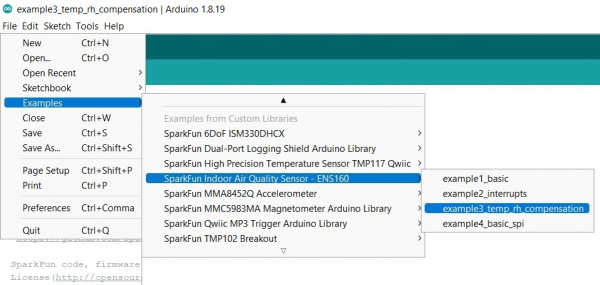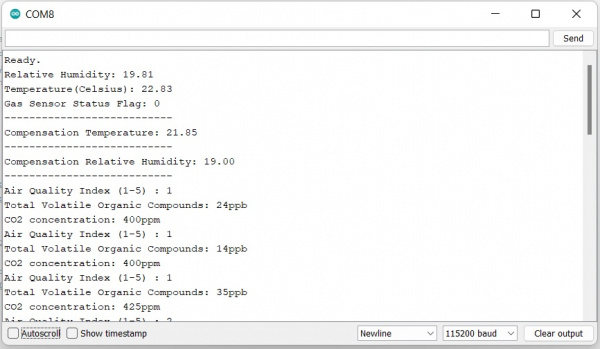SparkFun Indoor Air Quality Sensor - ENS160 (Qwiic) Hookup Guide
Example 3: Temp RH Compensation
This example shows how to give the ENS160 Temperature and Relative Humidity Data for compensation. Note that the values that are given for compensation are not populated in their registers until the Air Quality Sensor is set to "Standard" operation and when data is ready i.e. the data ready bit is set. Also note that there will be some rounding of the temperature and relative humidity values when they're given to the sensor and again when they're read back.
Go ahead and open up File->Examples->SparkFun Indoor Air Quality Sensor - ENS160->example3_temp_rh_compensation. Make sure to select your board (SparkFun RedBoard) and COM port before hitting upload to begin experimenting with the air quality sensor.
Alternatively, you can copy and paste the code below into a nice new Arduino sketch:
language:c
/* example3_temp_rh_compensation.ino
This example shows how to give the ENS160 Temperature and Relative Humidity
Data for compensation. Note that the values that are given for compensation are not
populated in their registers until the Air Quality Sensor is set to "Standard" operation
and when data is ready i.e. the data ready bit is set. Also note that there will be some
rounding of the temperature and relative humidity values when they're given to the sensor
and again when they're read back.
Written by:
Elias Santistevan @ SparkFun Electronics October, 2022
Products:
Air Quality Sensor - https://www.sparkfun.com/products/20844
Humidity and Temperature Sensor - https://www.sparkfun.com/products/16467
Repository:
https://github.com/sparkfun/SparkFun_Indoor_Air_Quality_Sensor-ENS160_Arduino_Library
SparkFun code, firmware, and software is released under the MIT
License(http://opensource.org/licenses/MIT).
*/
#include <Wire.h>
#include "SparkFun_ENS160.h"
#include "SparkFun_SHTC3.h" // Click here to get the library: http://librarymanager/All#SparkFun_SHTC3
SHTC3 mySHTC3; // Humidity and Temp Sensor.
SparkFun_ENS160 myENS;
bool printedCompensation = false;
int ensStatus;
float rh;
float tempC;
SHTC3_Status_TypeDef result;
void setup()
{
Wire.begin();
Serial.begin(115200);
if( !myENS.begin() )
{
Serial.println("Air Quality Sensor did not begin.");
while(1);
}
if( mySHTC3.begin() != SHTC3_Status_Nominal )
{
Serial.println("Humidity and Temperature Sensor did not begin.");
while(1);
}
// Reset the indoor air quality sensor's settings.
if( myENS.setOperatingMode(SFE_ENS160_RESET) )
Serial.println("Ready.");
delay(100);
// Device needs to be set to idle to apply any settings.
myENS.setOperatingMode(SFE_ENS160_IDLE);
mySHTC3.update(); // Send command to take a measurement
if( mySHTC3.lastStatus != SHTC3_Status_Nominal )
{
Serial.println("Humidity and Temperature Sensor is not ready.");
while(1);
}
rh = mySHTC3.toPercent();
tempC = mySHTC3.toDegC();
Serial.print("Relative Humidity: ");
Serial.println(rh);
Serial.print("Temperature(Celsius): ");
Serial.println(tempC);
// Give values to Air Quality Sensor.
myENS.setTempCompensationCelsius(tempC);
myENS.setRHCompensationFloat(rh);
delay(500);
// Set to standard operation
// Others include SFE_ENS160_DEEP_SLEEP and SFE_ENS160_IDLE
myENS.setOperatingMode(SFE_ENS160_STANDARD);
// There are four values here:
// 0 - Operating ok: Standard Opepration
// 1 - Warm-up: occurs for 3 minutes after power-on.
// 2 - Initial Start-up: Occurs for the first hour of operation.
// and only once in sensor's lifetime.
// 3 - No Valid Output
ensStatus = myENS.getFlags();
Serial.print("Gas Sensor Status Flag: ");
Serial.println(ensStatus);
}
void loop()
{
if( myENS.checkDataStatus() )
{
if( printedCompensation == false)
{
Serial.println("---------------------------");
Serial.print("Compensation Temperature: ");
Serial.println(myENS.getTempCelsius());
Serial.println("---------------------------");
Serial.print("Compensation Relative Humidity: ");
Serial.println(myENS.getRH());
Serial.println("---------------------------");
printedCompensation = true;
delay(500);
}
Serial.print("Air Quality Index (1-5) : ");
Serial.println(myENS.getAQI());
Serial.print("Total Volatile Organic Compounds: ");
Serial.print(myENS.getTVOC());
Serial.println("ppb");
Serial.print("CO2 concentration: ");
Serial.print(myENS.getECO2());
Serial.println("ppm");
}
delay(200);
}
Your hardware hookup should look something like the following:
Once you've got your code uploaded, open up a Serial Monitor and check out your output. You should see something like the following:


